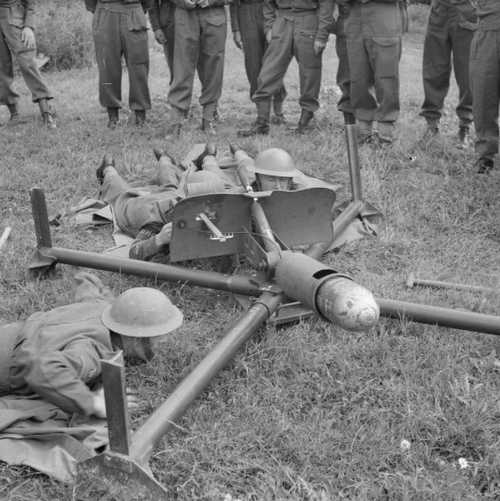
British Forces
Blacker Bombard -
H.M. Government/Imperial War Museum (IWM H 12299)
Men of the Saxmundham, Suffolk, Home Guard man a Blacker Bombard on a "mobile/portable" mount during a training session with War Office instructors, 30 July, 1941 (note the daisies in the grass). In order to fire a "Blacker", one needed to mount it either on this large, "spider-shaped" mount or in a concrete pillar in a fixed firing pit. The Blacker Bombard was regarded as an "infantry antitank" weapon; however, by the standards of such weapons, it was very heavy and not easily portable. It took three, or perhaps four men to move this "mobile" rig any distance - not helpful in a combat situation, in which the short range of the "Blacker" might enforce a quick retreat ... Best regards, JR. This is a Home Guard demonstration of the Blacker Bombard anti-tank mortar, originally designed in the 1930s by Lieutenant Colonel Stewart Blacker, and rejected by the War Office at the time. However, it was demonstrated to Winston Churchill in late-1940 (the time of the great artillery shortage), and the Prime Minister was quite taken with it. As a result, it joined Churchill's other improbable wonder weapons, the Smith Gun and the Northover Projector, into production. Unlike the Smith and the Northover, the Blacker was extensively distributed to the British Army as well as the Home Guard. Over 20,000 were made during the war. The Blacker Projector was by nature a spigot mortar of 29 mm calibre - although one could say that the actual calibre was that of the spigot round at its widest, projecting from the barrell of the mortar. The principal ammunition was a 20-pound shaped charge antitank round; 14-pound anti-personnel rounds were also manufactured. It was, perhaps, potentially a bit more useful than Churchill's other odd favourites, the Smith and the Northover. First - it did not have any (significant) reputation for killing or injuring its own crews. Secondly, with a decent shot and a bit of luck, the 20-pound antitank round could have a pretty reasonable chance of punching some sort of hole in a tank of the early war period. However ... on balance, it was still not much use. First, range was short - nobody claimed a "carry" much above 100 yards, and the weapon was accounted better at somewhat closer ranges. Secondly, both the mortar itself and its ammunition were very heavy, a problem only partly addressed by the fact that the assembly could be dismantled into about 11 pieces for transport. As a result, many Blackers were used, not on their moveable quadruped base-frames, but on fixed circular concrete bases, often set in prepared gun pits placed in "strategic" positions (these still have a way of turning up unexpectedly in overgrown back gardens to this day). Thirdly, like all spigot mortars, the Blacker was a muzzle-loader - making reloading problematic where somebody was shooting at you at the time. Then there is the fact that, for a weapon with such a short range, it was quite large and prominent, and concealment would be a must if it were ever to get a shot at a tank before it was eliminated by the tank's machine-guns. All things considered, it is perhaps just as well (for those called upon to use it) that, apart from some employment as an anti-personnel weapon in North Africa, the Blacker seems to have seen little or no action. Like the Smith Gun and the Northover Projector, the Blacker was seen as an interim measure, pending the arrival of more capable weapons. Having commenced issue in late-1941, no further Blacker Bombards were issued after July 1942. Best regards, JR.
4048 Views
5/20/2014
